Aquaculture: are the criticisms justified? Feeding fish to fish
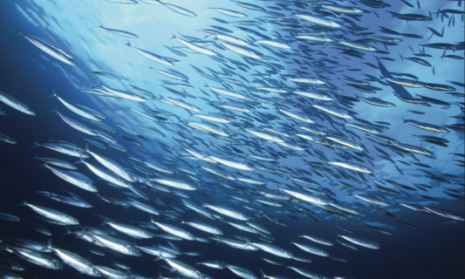
Summary
Aquaculture is a fast-growing sector of livestock production, but has attracted criticism owing to the practice of using marine ingredients as feed, usually in the form of fishmeal and fish oil. After placing so-called production of ‘fed’ aqua- culture within the global supply context of capture fisheries and aquaculture, the author lists the objections made against feeding fish to fish.
This is followed by a survey of the current trends in the production of fishmeal and fish oil from raw materials of marine origin and of the changing pattern of inclusion in aquaculture feeds, as well as their use in land animal feeds and human nutritional products. The management of so-called ‘reduction’ fisheries (for fish not used for direct human consumption) is discussed, as is the use of process trimmings and fishery by-products to make fishmeal, together with the increasing effort to utilise, for human consumption, fish that would previously have been used for reduction.
Particular attention is paid to the substitution of marine feed ingredients by vegetable proteins and oils and by recycled land animal products in aquaculture diets.
A global input and output analysis indicates that there is a substantial net production of fish owing to use of marine ingredients for aquaculture feed and that continuing future growth of aquaculture is unlikely to threaten stocks of wild fish currently used for reduction. This counters a principal criticism of using marine ingredients.
However, areas of potential concern are recognised, especially the use of low value ‘trash fish’ in South East Asia as direct wet feed for aquaculture; also the availability of long chain omega-3 marine oils for aquaculture owing to the growth in human nutritional supplements. It is concluded that future growth of fed aquaculture will be associated with proportionately greater use of land animal and plant proteins, oils and carbohydrate sources, and with a continuing decline in depend- ence on marine ingredients.
Keywords: Aquaculture, substitution, by-products, sustainability, pelagic, reduction, forage, fishmeal, fish oil.
Glossary
Dioxins and dioxin-like compounds are by-products of various industrial processes and regarded as highly toxic compounds that are persistent organic environmental pollutants
El Niño is a warming of the surface water of the eastern or central Pacific Ocean which usually occurs every 4 to 12 years causing unusual weather patterns and affecting marine fish stocks
The fishmeal trap is a term denoting the concern that increased demand for feed by aquaculture will increase fishing pressure on wild stocks and, therefore, threaten the sustainability of the associated capture fisheries. Fed aquaculture and Non-fed aquaculture are those branches of aquaculture which depend respectively either on supplemental feeding, which may include formulated diets, or a reliance on naturally supplied feed, which may be encouraged by adding fertilizers to the water. Frames are filleted fish skeletons with the heads and guts intact. A nutraceutical is a food or nutritional product that provides human health and medical benefits. Pelagic fish are those which live near the surface or in the water column of seas or lakes, but not on the bottom.
A prion is an infectious agent composed of protein in a mis-folded form, including the causative agent of Mad Cow Disease (Bovine spongiform encephalopathy, BSE). A reduction fishery is a fishery that ‘reduces’ its catch to fishmeal and fish oil (i.e. not for direct human consumption); also known as a ‘Feed’ fishery or a ‘Forage’ fishery. Trash fish are low value fish having little or no market value as human food but sometimes used as a minced- up raw wet feed for aquaculture. The trophic level of an organism is the position it occupies in a food chain.
Abbreviations
FAO Food and Agriculture Organisation of the United Nations; OECD Organisation for Economic Co-operation and Development; FIFO when used about aquaculture is the ratio of (wild-caught) Fish in, to (farmed) Fish out and refers to the input of fish materials as feed ingredients compared to the resulting output of farmed fish; IFFO-RS Global Standard and Certification Programme for the Responsible Supply of Fishmeal and Fish Oil (developed by the International Fishmeal and Fish Oil Organisation); NGO non-governmental organisation; PCBs polychlorinated biphenyls, - a family of synthetic organic chemicals also known as chlorinated hydrocarbons.
Introduction
Aquaculture is the farming of aquatic plants and animals; it has grown at an annual average rate of 5.8% by tonnage volume in the last decade, but the OECD anticipates a slowing down to 2.4% annually during the period 2012 – 20211. In contrast to this growth in aquaculture, global fisheries production has now levelled off.
As illustrated in Fig. 1, FAO reports that in 2010 capture fisheries and aquaculture supplied the world with about 148 million tonnes of fish (with a total value of USD 217.5 billion), of which about 128 million tonnes was utilised directly as human food; preliminary data for 2011 indicate increased production of 154 million tonnes, of which 131 million tonnes was destined as food. In 2010 global production of farmed food fish was 59.9 million tonnes, of which an estimated 67% were fed, instead of relying on natural productivity often boosted by fertilization of the rearing pond2.
Fig. 2 shows how the production of this so-called ‘fed’ aquaculture has developed, and is eclipsing non-fed aquaculture, and the main species groups involved in each.
To a varying extent, depending on species, fed aquaculture receives marine ingredients as a dietary component usually by means of fishmeal and fish oil incorporated during feed manufacture. These marine ingredients are manufactured by the fishmeal industry using either rendered whole fish – mainly small pelagic species, such as Peruvian anchovy, caught by means of targeted ‘reduction’ fisheries (also known as ‘forage’ or ‘feed’ fisheries), or alternatively rendered from by- products of processing captured or farmed fish for human consumption (i.e. offals, off-cuts, frames, and trimmings).
The fresh raw materials are then subjected to cooking, pressing, drying and milling to produce the brown flour known as fishmeal. During this process the liquid fraction is separated into oil and water followed by an evaporation step leading to fish oil production.
The use of marine ingredients other than for direct human food production has caused controversy. Most fishmeal and fish oil is used today for aquaculture, which has itself attracted criticism mainly on environmental grounds. The main global concern is that increased demand for feed from a growing aquaculture production will increase fishing pressure on wild stocks to supply fishmeal and fish oil and consequently threaten the sustainability of the capture fisheries involved. After initially listing these and other criticisms, the relevant aspects of feeding fish to fish will be described in order to enable a more detailed assessment of their validity both now and for the future.
The criticisms of feeding fish to fish
The so-called ‘Fishmeal trap’ expresses the concern that overfishing of wild fish for use as aquaculture feed threat- ens the sustainability of reduction fish- eries; a linked concern is that aquacul- ture is so reliant on the supply of marine ingredients that limited supply will inevitably constrain its further development3. For this to be true vari- ous factors need to be understood, including whether increased fishmeal demand results in an increased fishing catch and the extent to which fishmeal can be substituted in fish feeds (e.g. so that increasing fishmeal prices encour- age use of alternative raw materials4).
A common criticism by fishery ecologists is that reduction fisheries compromise marine bird, mammal, and predatory fish populations5,6. The objections are on both ecological grounds, linked to biodiversity, and economic grounds, as it is supposed that a valuable catch of fish for human consumption is being denied or reduced due to the operation of a reduction fishery catching (‘lower trophic level’) fish further down the food chain7,8.
Some critics believe that all fish should be processed for human food rather than for livestock feed. When it is argued that there is little or no consumer demand for certain fish species, the reply has been that such fish should then be given to the poor free of charge (e.g. in the case of Peruvian anchovy and poor rural communities of Andean people).
A particular source of criticism is the farming of so-called ‘carnivorous‘ fish, such as Atlantic salmon (Salmo salar), which have a relatively higher dietary inclusion of fishmeal and fish oil, implying an inefficient utilisation of scarce marine biomass9,10, compared with those species which can be reared on vegetarian diets.
Also there are claims that reduction fisheries are overfished and that exploitation rates should be drastically reduced6. Furthermore it is suggested that use of fishmeal and fish oil is wrong on public health grounds as it results in the concentration of marine contaminants, which then enter the food chain via aquaculture products11. Finally one may ask if there is a risk of fish to fish disease transmission by feeding marine ingredients to farmed fish.
The supply base of marine raw materials
It is estimated that ca 25% of current fishmeal and fish oil supplies are derived from the fishery by-products of processing for human consumption and hence recycle waste which would otherwise incur financial and environ- mental costs for disposal. This resource is under-exploited today and is expect- ed to provide 43% of the raw material input within the next 10 years2. However, most concerns centre on the capture fishery element of the raw material base, as follows:
(i)Why are whole fish captured for reduction not used instead for human consumption?
The main species and volumes of whole fish used in manufacture of fish- meal and fish oil during 2006 – 2010 are classified into three categories (industrial grade, food grade, and prime food) and listed in Table 1. This categorisation12,13 is based on the view that industrial grade fish, such as Atlantic menhaden (Brevoortia tyrannus) or Gulf menhaden (Brevoortia patronus), are unsuitable for human food and have no current market other than fishmeal or fish oil.
For food grade fish, such as Peruvian anchovy (Engraulis ringens), those willing to pur- chase them as food are far away and cannot normally pay for the costs asso- ciated with preservation and trans- portation; there has been limited suc- cess in promoting Peruvian anchovy for direct human consumption (only 1.5% of the anchovy catch by volume went for human consumption in 201114) despite strenuous efforts.
As their name implies, prime food fish are very suitable for food markets, but owing to the seasonality and unpre- dictability of pelagic harvests, there will be occasions when landings are too large for all to be preserved or processed as human food. At such times the smaller and poorer quality fish are diverted for reduction.
However, in recent years there has been a marked reduction in use of prime food fish, such as herring (Clupea harengus) or Jack mackerel (Trachurus murphyi) for reduction, other than as offals or downgraded fish. This is part of an overall increasing trend in the proportion of the world fish catch going for human consumption, – rising from about 68% in the 1980s to 86% in 2010 according to FAO15.
(ii)How robust are the fish stocks used for reduction?
Fish stocks for reduction are subject to increasing regulation and control by governments, while the quality of stock management is being increasingly monitored by independent NGOs, as well as by government and industry sources.
The FAO16 has published tech- nical guidelines on the use of wild fish as feed for aquaculture in support of the FAO Code of Conduct for Responsible Fisheries17. The Sustainable Fisheries Partnership18 analysed how the main reduction fisheries, around South America and across the Atlantic, score using ‘FishSource’ methodology.
They concluded that ‘most operate within limits that would be considered consistent with current good industry practice in the context of single-species management regimes’, adding that ‘all would be enhanced by the incorpora- tion of ecosystem principles into the overall management regime’. The aquaculture value chain is now putting pressure on the fishmeal industry for certification to demonstrate sustainable use of raw materials and on feed buyers to purchase from certified sources. In this connection it is claimed that over a third of the world’s fish- meal and fish oil production is now certified to the IFFO-RS global standard for responsible supply19.
By far the world’s largest reduction fishery is that of Peruvian anchovy, with an annual catch, subject to peri- odic El Niño events, during the period 2000 to 2006, varying from 6 to 10 million tonnes and representing 25% to 30% or more of global fishmeal pro- duction depending on the year. It is, therefore, significant that in 2008 Mondoux et al.20 ranked Peru the high- est out of 53 maritime countries for the sustainability of its fisheries.
Since then Peru has reduced its fishing over- capacity and further improved its man- agement by the introduction of maxi- mum catch limits for each vessel. Today, the main problems associated with overfishing and poor fishery con- trols appear to be in China and South East Asia, especially related to use of low value ‘trash’ fish21. Apart from Asia, increasingly stringent controls are now being applied to those fisheries used primarily for reduction purposes, such as Peruvian anchovy and menhaden. Their stocks appear reasonably robust and are classed by FAO as fully exploit- ed22.
However, continuing vigilance is needed since there is a growing recog- nition that climate-driven changes are affecting some pelagic fish popula- tions. The reduced seasonal availability of sandeels (Ammodytes spp.) in the North Sea is linked to seawater tem- perature changes, which in turn have resulted in the decline of certain species of seabird23 and of marine mammals24, as well as in lower quotas being issued by the European Union (EU) for the associated reduction fish- ery.
(iii)Should whole fish targeted for reduction be left in the sea?
The Lenfest Ocean program has recently concluded25 that conventional management can be risky for forage fish because it does not adequately account for their wide population swings and high catchability. They claim it also fails to include the critical role of forage fish as food for marine mammals, seabirds, and commercially important fish, such as tuna, cod, and salmon. Lenfest, therefore, recom- mended cutting catch rates in half in many ecosystems and doubling the minimum biomass that should be left in the water compared with conventional management targets.
In assessing the validity of these argu- ments, the following points are made: I Small pelagic fish populations cer- tainly fluctuate widely and are easily reduced, and so should be well man- aged. However, recoverability is equally important. The largest fishery (Peruvian anchovy) suffered a severe El Niño in 2010, but stocks rebounded strongly in 2011 suggesting that in practice the present management regime may be suitable.
Until recently there have been justified concerns about the status of some North Sea reduction stocks with an inability to agree quotas linked to political differences in the EU and the Common Fisheries Policy. Whereas there is continuing room for improve- ment, the overall North Sea picture is now of recovery or of stability, notwithstanding the effects of climate change on sandeel stocks, which indi- cates that an inherent problem with conventional management is not the main issue.
At the same time continu- ing problems with managing the Jack mackerel resource were closely linked to its migration beyond the Chilean jurisdiction and the difficulty in estab- lishing an international fishing agree- ment. It is therefore encouraging that ratification by Chile during 2012 of the South Pacific Regional Fisheries Management Organisation has made the agreement legally binding.
I It is certainly true that the activities of reduction fishing cause a decrease in predator populations. Striking an appropriate balance between seabird or marine mammal stocks and pelagic fish stocks implies making a similar judgment as between food security and biodiversity (akin to the ‘set-aside’ question in agriculture).
There is no simple answer and one practical solu- tion is the creation of marine reserves to safeguard breeding populations, especially of endangered species. I As regards the view that forage fish are more valuable in the water than in the net, this ignores the conversion ratio in the wild which is of the order of10kgofpreyto1kgoffoodfish, whereas the aquaculture alternative is much more productive (see paragraph 15 (ii)).
(iv)Are there valid human health concerns about eating farmed fish?
On grounds of public health a report about the presence of organic contam- inants in farmed salmon11 raised con- cerns about eating farmed fish owing to the presence of marine contami- nants in marine ingredients, which then enter the food chain via aquacul-
ture products. It has since been shown that the potential health risks are extremely small compared to the health benefits of consuming salmon products. Indeed the benefits are esti- mated to be at least 100-fold greater than the estimates of harm, which may not exist at all26,27. In any event recent data28 show that farmed salmon and trout contained on average lower levels of dioxins and PCBs than wild-caught salmon and trout, at least for Europe.
Following the discovery of a prion pro- tein in fish29, concerns were expressed about the possibility of fish suffering a version of ‘mad cow disease’. It appears that fish prions are different from those in mammals and it is unlikely that transmission could jump from fish to mammals30. Nevertheless it is now recognised aquaculture practice to avoid feeding fish material to other fish of the same or closely related species.
The risk of transmitting disease organisms from fish to fish by feeding marine ingredients is low when using properly stored fishmeal owing to the high processing temperatures involved in feed manufacture, but more likely with wet fish diets31.
Production and markets for marine ingredients
The total annual supply of fishmeal and fish oil worldwide between 1964 and 2010 is shown in Fig. 3. This supply has stabilized at about 5 million tonnes and 1 million tonnes per annum respectively despite El Niño events. This is clearly less than the 1994 peak and the decline is due to stricter fishing controls, increased processing for human consumption of fish used formerly for fishmeal, and other factors, such as climate-change effects32,33.
Fig. 4 illustrates the use in 2010 of fishmeal and fish oil, in aquaculture, representing 73% and 71% of world consumption respectively. The main competitor of aquaculture for fishmeal is pig feed, especially for young pigs at weaning, but aquaculture is gradually taking market share from land animals as pig farmers tend to be more price sensitive than fish farmers and substitute with other ingredients when fishmeal prices increase.
The opposite is true for the growing demand from nutraceutical producers of human nutritional supplements (e.g. capsules), where buyers will pay a 20% – 25% premium for fish oil with a high level of omega-3 fatty acids. This is raising concern about the medium-term sustainability of fish oil supplies for aquaculture feed pending the commercialisation of newer sources of the key long chain omega-3 fatty acids.
Inclusion of marine ingredients in aquaculture feeds
(i)Suitability for substitution and dietary inclusion rates
Fig. 5 illustrates the reduction in fish- meal and fish oil inclusion rates during the period from 1995 to 2010 for the main aquaculture species groups34.
This reflects the ingenuity of fish nutritionists and feed formulators in substituting fishmeal and fish oil with non-marine ingredients, mainly of veg- etable origin (e.g. soyabean meal and rapeseed oil).
Their motivation has been diet cost reduction and formulation flexibility, whereas marine ingredients are of lim- ited and variable supply, which is sub- ject to unpredictable events such as El Niño.
Fishmeal represents only 4% of total protein meal4 and is not an essential feed ingredient for aquaculture per se, but it provides a near-optimal com- plete feed in a convenient, cost-effec- tive form35.
The same is true of fish oil and a fish’s requirement for long chain omega-3 fats can be met with low dietary levels of fish oil, so it is possible to replace up to 100% and around 70% in diets for salmonids and marine fish respectively, provided their omega- 3 fatty acid requirements are met by other ingredients, such as fishmeal36.
At the same time fish genetics is playing an important role in substitu- tion since breeding programmes are improving the biological ability of salmonids to use novel plant-based diets37.
(ii)Fish-in fish-out ratios and aquacul- ture’s marine dependency
Aquaculture critics frequently claim that 4 or 5 kg of fish are needed to produce 1 kg of carnivorous farmed fish (a fish-in fish-out ratio, or so-called ‘FIFO’, of 4:1 or 5:1).
Table 3 represents a mass-balance of inputs (fishmeal and fish oil tonnage) and outputs (fed aquaculture tonnage) to calculate an overall FIFO for 2010 of 0.33:1, down from 0.6:1 in 2000 owing to substitution.
It has been shown33 that over this same 10 year period the FIFO ratio of farmed salmonids fell from 2.6:1 to 1.4:1 and for farmed crustaceans (mainly shrimps) from 0.9:1 to 0.4:1.
It is true that farmed salmon are still net consumers of marine ingredients, but their FIFO ratio is fast approaching parity.
For example, using low dietary levels of marine ingredients, farmed Atlantic salmon can be net producers of fish protein and oil with sufficient long chain omega-3 fatty acids produced to meet human health recommenda- tions38.
Interestingly, it also appears that Atlantic salmon can be net producers of the marine long-chain omega-3 fatty acid, DHA, when dietary fish oil is replaced by vegetable oil39.
Given these developments it is diffi- cult to sustain the view that feeding fish to fish is a wasteful use of scarce resources and hence unsustainable, even for those species which are tradi- tionally classed as carnivorous fish.
(iii)Will finite supplies of marine ingredients limit aquaculture growth?
Fig. 6 shows that over the period 2000 to 2010, while fed aquaculture production continued to climb, the use of fishmeal in aquaculture feeds rose until 2005 and then began to plateau before falling in 2010, whereas fish oil consumption remained fairly stable until falling after 2007.
Fishmeal consumption is projected at 3.63 million tonnes in 2015 and only 3.49 million tonnes by 2020, despite projected increases of 143% and 168% in estimated total aquafeed and fed aquaculture production, respectively2,34; this decreased use of fishmeal is predi- cated on a decreased supply from more regulated fishing, with a conse- quential increased price, and increased use of more cost-effective fishmeal sub- stitutes.
Although the availability of fishmeal, and probably fish oil, over the next ten years may not be a major constraint, other feed ingredient inputs, such as soyabean, maize, and rendered animal by-products2,40, will need to expand at a rate to sustain this growth.
It should be added that fish oil sup- ply could well become a constraint within the next 5 years owing to com- petition by the fast-growing nutraceu- ticals industry for the long chain omega-3 fatty acids in fish oil41,42. This is unlikely to limit the con- tinuing growth of aquaculture, but is likely to reduce the content of omega- 3 fats and increase the level of omega- 6 fats in the final product with poten- tially negative consumer health impli- cations43. However, alternative algal production of these omega-3 fatty acids has already commenced to sup- ply nutraceuticals, while research to develop genetically-modified (GM) omega-3 oils from oilseeds, such as soyabean, rapeseed and related species, is showing commercial prom- ise, despite a lack of universal market acceptance for GM materials44.
Conclusions
- Nutritional and genetic innovation is enabling substitution of fishmeal by other feed ingredients. The use of fish- meal and fish oil in aquaculture diets is static and there is every likelihood that aquaculture will continue its rapid global expansion despite a limited global supply of marine ingredients.
- Except for concerns around poorly managed Asian fisheries, the evidence is that in general reduction fisheries are being managed responsibly, therefore increased demand for fishmeal and fish oil is unlikely to result in increased catches for reduction. Taking also into account substitutability, there seems little risk of a fishmeal trap, at least out- side Asia.
- There is a medium-term concern regarding fish oil owing to the growth of demand for human consumption. It seems unlikely that this will constrain aquaculture production, but it will cer- tainly reduce the content of long chain omega-3 fatty acids in some farmed fish until such time as cost-effective alternative sources currently under development become available.
- Striking the right balance between the level of reduction catch and leav- ing fish in the water for predatory fish, birds and mammals is as much down to subjective judgement as to scientific method, but probably all fisheries would benefit from adopting ecosys- tem management. It seems, however, that calculations of the costs and bene- fits of reduction fishing are likely to be erroneous if they ignore the far greater conversion efficiency of aquaculture cf. wild fish with natural predation by other fish in the wild.
- Using fish landed by industrial fish- eries in the Americas and Europe as feed for aquaculture in the long run significantly expands the effective sup- ply of fish for human consumption, – to the extent of at least 11 million tonnes net increment per annum35. As regards the ethical argument that it is morally wrong to feed fish to fish and crustaceans; taking Peruvian anchovy as an example, it is clear that there is a lack of effective demand for human consumption in respect of most of the anchovy caught (despite promotional effort), as the potential consumers live far from the site of the catch. If 8 mil- lion tonnes were to be supplied instead as a canned product, the annual cost would be in the order of USD 25 bil- lion per year, – this is not a feasible solution and a subsidized product could well be challenged under World Trade Organisation rules13.
- From having been commodities sup- plying bulk protein and energy, it seems that fishmeal and fish oil are now speciality feed ingredients for aquaculture, used strategically and sparingly. Innovation has underpinned the dramatic growth in aquaculture and dietary development. In the same way the signs are that medium- and longer-term concerns about availability of long chain omega-3 fatty acids will be resolved by algal cultivation and plant breeding of those fatty acids.
- Aquaculture will soon overtake con- ventional fishing as the major source of seafood for human consumption. As such, aquaculture already represents a key element of food security in some regions and its sustainability is more closely linked to the availability of ter- restrial feed ingredients than to those of marine origin.
Acknowledgements
Particular thanks are due to Anne Chamberlain, Mark Griffin, Andrew Jackson, David Jones, and Dan Lee, who kindly commented on earlier ver- sions of the manuscript.
References
1. OECD/FAO (2012) OECD-FAO Agricultural outlook 2012-2021, <http://dx.doi.org/10.18787/agr_outlook- 2012-en>.
2. FAO (2012a) The state of world fisheries and aquaculture – 2012, Rome, FAO Fisheries and aquaculture department, the Food & Agriculture Organisation of the United Nations.
3. Naylor, R L, Hardy, R W, Bureau, D P, Chiu, A, Elliott, M & Farrell, A P (2009) Feeding aquaculture in an era of finite resources. Proceedings of the National Academy of Sciences of the United States of America, 106, 15103- 15110.
4. Asche, F & Bjørndal, T (2011) The economics of salmon aquaculture. Second Edition, Chichester, Wiley-Blackwell, 2011 ISBN 978-0- 8523-8289-9.
5. Cury, P M, Boyd, I L, Bonhommeau, S, Anker-Nilssen, T, Crawford, R J M, Furness, R W, Mills, J A, Murphy, E J, Ósterblom, H, Paleczny, M, Platt, J F, Roux, J-P, Shannon, L & Sydeman, W J (2011) Global seabird response to forage fish depletion – one third for the birds. Science, 334, 1703-1706.
6. Smith, A D M, Brown, C J, Bulman, C M, Fulton, E A, Johnson, P, Kaplan, I C, Lozano- Montes, H, Mackinson, S, Marzloff, M, Shannon, L J, Shin, Y-J & Tam, J (2011) Impacts of fishing low-trophic level species on marine ecosystems. Science, 333, 1147-1150.
7. Pauly, D, Christensen, V, Dalsgaard, J, Froese, R & Torres, F (1998) Fishing down marine food webs. Science, 279, 1360-1366.
8. Alder, J, Campbell, B, Karpouzi, V, Kashner, K & Pauly, D (2008) Forage fish: from ecosys- tem to markets. Annual Review of Environment and Resources, 33,153-166.
9. Allsopp, M P, Johnston, P & Santillo, D (2008) Challenging the aquaculture industry on sustainability. Amsterdam, Greenpeace International.
10. Welch, A, Hoenig, R, Steiglitz, J, Benetti, D, Tacon, A, Sims, N & O’Hanlon, B (2010) From fishing to the sustainable farming of carnivo- rous marine finfish, Reviews in Fisheries Science, 18, 235–247.
11. Hites, R A, Foran, J A, Carpenter, D O, Hamilton, M C, Knuth, B A & Schwager, S J (2004) Global assessment of organic contami- nants in farmed salmon. Science, 303, 226- 229.
12. Peron, G, Mittaine, J F & Le Gallic, B (2010) Where do fishmeal and fish oil products come from ? An analysis of the conversion ratios in the global fishmeal industry. Marine Policy, 34, 815-820.
13. Wijkström, U N (2012) Is feeding fish with fish a viable practice? In: Farming the Waters for People and Food (eds., Subasinghe, R P, Arthur, J R, Bartley, D M, De Silva, S S, Halwart, M, Hishamunda, N, Mohan, C V and Sorgeloos, P). Proceedings of the Global Conference on Aquaculture 2010, Phuket, Thailand. FAO, Rome and NACA, Bangkok, 22-25 September 2010 pp.33-35.
14. Produce (2011) Desembarque de recursos hidrobiológicos marítimos por tipo de uti- lización según especie. Ministry of Production, Government of Peru, Lima, Peru. <www.pro- duce.gob.pe/RepositorioAPS/3/jer/DESEMSUB- MENU01/2011/diciembre/0103.pdf>.
15. FAO (2012b) FAO Fisheries Department, Fishery Information, Data and Statistics Unit. Fishstat Plus: Universal software for fishery sta- tistical time series. Aquaculture production: quantities 1950 – 2010, Aquaculture produc- tion: values 1984 – 2010; Capture production: 1950 – 2010; Commodities production and trade: 1950 – 2010; Version 2.30.
16. FAO (2011) Aquaculture development. 5. Use of wild fish as feed in aquaculture. FAO Technical Guidelines for Responsible Fisheries. No. 5, Suppl. 5. Rome, FAO. 70p.
17. FAO (1995) Code of Conduct for Responsible Fisheries, Rome, FAO, 1995 ISBN 92-5-103834-5.
18. Sustainable Fisheries Partnership (2012) Global sustainability overview of fisheries used for fishmeal and fish oil. <http://www.sustain- ablefish.org/about-us/staff/staff-list> accessed June 2012.
19. IFFO (2012) International Fishmeal and Fish Oil Organisation. Global Standard for Responsible Supply (IFFO-RS). <www.iffo.net>.
20. Mondoux, S, Pitcher, T & Pauly, D (2008) Ranking maritime countries by the sustainabili- ty of their fisheries. In: Fisheries Centre Research Report (eds., J Alder and D Pauly), 16, 13-27.
21. Funge-Smith, S, Lindebo, E & Staples, D (2011) Asian fisheries today: the production and use of low-value/trash fish from marine fisheries in the Asia-Pacific region. Bangkok, The Asia- Pacific Fishery Commission, RAP Publication 2005/16, 47 pp.
22. FAO (2010) The state of world fisheries and aquaculture 2010. Rome, Italy, FAO Fisheries and aquaculture department, The Food and Agriculture Organisation of the United Nations, 218 pp.
23. Frederiksen, M, Wanless, S, Harris, M P, Rothery, P & Wilson, L J (2004) The role of industrial fisheries and oceanographic change in the decline of North Sea black-legged kitti- wakes. Journal of Applied Ecology, 41, 1129- 1139.
24. Macleod, C D, Begoña Santos, M, Reid, R J, Scott, B E & Pierce, G J (2007) Linking sandeel consumption and the likelihood of starvation in harbour porpoises in the Scottish North Sea: could climate change mean more starving porpoises? Biology Letters 3, 185-188.
25. Lenfest (2012) Little fish big impact. A report from the Lenfest Forage Fish Task Force, Washington D.C., USA, Lenfest Ocean Program, 108pp.
26. Cohen, J T, Bellinger, D C & Connor, W E (2005) A quantitative risk-benefit analysis of changes in population fish consumption. American Journal of Preventive Medicine, 29, 325-334.
27. Mozaffarian, D & Rimm, E B (2006) Fish intake, contaminants, and human health – evaluating the risks and the benefits. Journal of the American Medical Association, 29, 1885–1895.
28. European Food Safety Authority (2012) Update of the monitoring of levels of dioxin and PCBs in food and feed. Scientific Report of EFSA. EFSA Journal, 10, 2832.
29. Rivera-Milla, E, Stuermer, C A O & Málaga-Trillo, E (2003) An evolutionary basis for scrapie disease: identification of a fish prion mRNA. Trends in Genetics, 19, 72-75.
30. Málaga-Trillo, E, Salta, E, Figueras, A, Panagiotidis, C & Sklaviadis, T (2011) Fish models in prion biology: underwater issues. Biochimica et Biophysica Acta, 1812, 402-414.
31. Roberts, R J & Shepherd, C J (1997). Handbook of trout and salmon diseases. Third Edition, Oxford, Blackwell Science, 1997 ISBN 0 85238 244 8.
32. Mittaine, J F (2012). World fishmeal and oil supply/demand and outlook for market trends. In: 7th JCI Spring Conference on Chinese feed raw materials market. Hainan, China, 22 – 23 March 2012.
33. Shepherd, C J & Jackson, A J (2012). Global fishmeal and fish oil supply – inputs, outputs and markets. Journal of Fish Biology (In Press).
34. Tacon,AGJ,Hasan,MR&Metian,M (2011). Demand and supply of ingredients for farmed fish and crustaceans - trends and prospects. FAO Fisheries and Aquaculture Technical Paper No. 564. FAO, 87 pp.
35. Tacon, A G & Metian, M (2008). Global overview on the use of fishmeal and fish oil in industrially compounded aquafeeds: trends and future prospects. Aquaculture, 285, 146 – 158.
36. Turchini, G M, Ng, W-K. & Tocher, D R (2011). Fish oil replacement and alternative lipid sources in aquaculture feeds. Baton Rouge, CRC Press, 2011 ISBN 978-1-4398-0862-7.
37. Quinton, C D, Kause, A, Koskela, J & Ritola, A (2007). Breeding salmonids for feed efficiency in current fishmeal and future plant- based diet environments. Genetics Selection Evolution 39, 431-446.
38. Crampton, V O, Nanton, D A, Ruohonen, K, Skjervold, P-O, & El-Mowafi, A (2010). Demonstration of salmon farming as a net producer of fish protein and oil. Aquaculture Nutrition, 16, 437-446.
39. Sanden, M, Stubhaug, I, Berntssen, M H G, Lie, Ø & Torstensen, B E (2011). Atlantic salmon (Salmo salar) as a net producer of long-chain marine omega-3 fatty acids. Journal of Agricultural and Food Chemistry, 59, 12697- 12706.
40. Olsen, R L & Hasan, M R (2012). A limited supply of fishmeal: impact on future increases in global aquaculture production. Trends in Food Science & Technology, 27, 120-128.
41. Ismail, A (2010). The future of fish oils in the omega-3 market. Presentation to the IFFO members’ Meeting. The International Fishmeal and Fish Oil Organisation, Miami, USA, 14 April 2010.
42. Steine, G, Tveterås, R and Pettersen, I (2011). Fish oil availability going forward – based on a memorandum to the Norwegian Seafood Federation. Presentation on 12th May 2011.
43. Shepherd, C J (2012). Implications of increased competition for fish oil. Bergen, FishfarmingXpert, September 2012, 5, 40-45.
44. Jackson, A J (2012). The growing demand for novel long chain omega-3 supplies. Presentation to the Omega-3 Summit, Ghent, Belgium, 23 April 2012.
Download pdfFigures
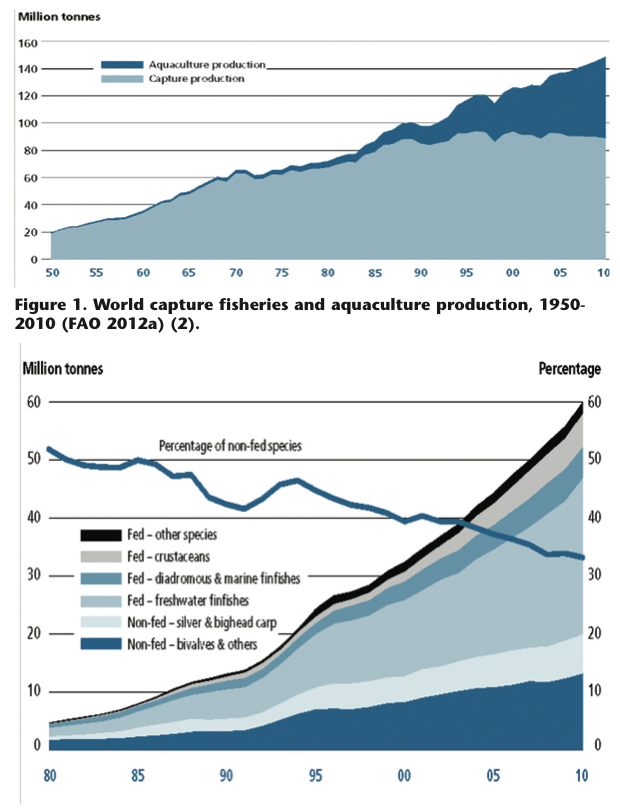
Figure 1. World capture fisheries and aquaculture production, 1950- 2010 (FAO 2012a) (2).
Figure 2. World aquaculture production of non-fed and fed species, 1980-2010 (FAO 2012a) (2).
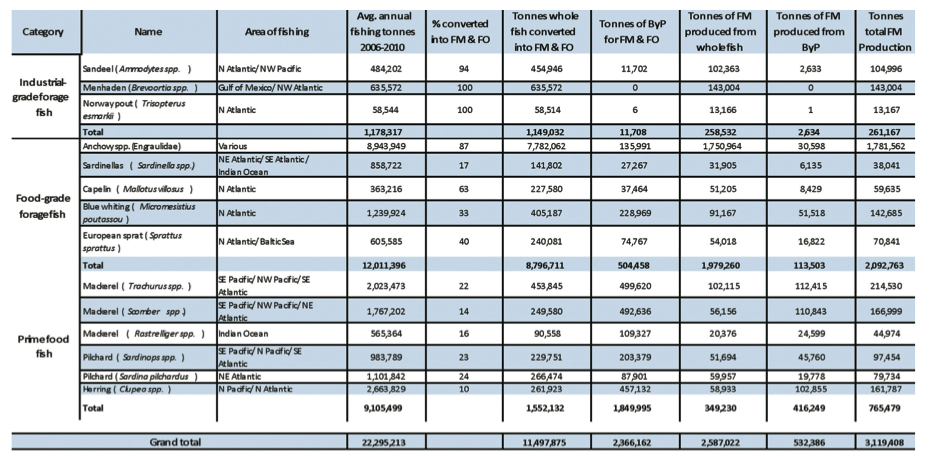
Table 1. Annual global pelagic fishery landings for reduction (average 2006–2010). FM = Fishmeal, FO = Fish Oil, ByP = By-products. (Units of production volume in tonnes). (Modified from Wijkström 2012 using data from FAO 2012b and IFFO estimates) (13,15).
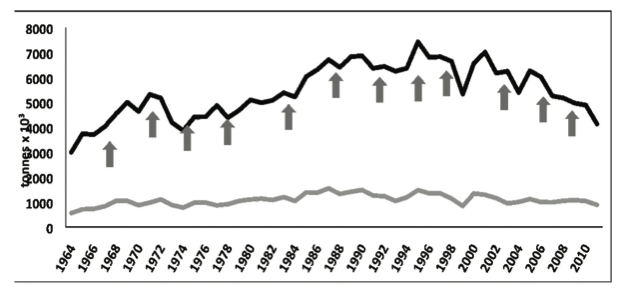
Figure 3. World fishmeal and fish oil production for 1964 – 2010 (tonnes x 103) where is for production of fishmeal, for production of fish oil and arrows indicate the El Niño years (source: Shepherd & Jackson 2012) (33)

Figure 4. Global consumption of fishmeal (A) and fish oil (B) by mar- ket segment in 2010. (Source: IFFO)
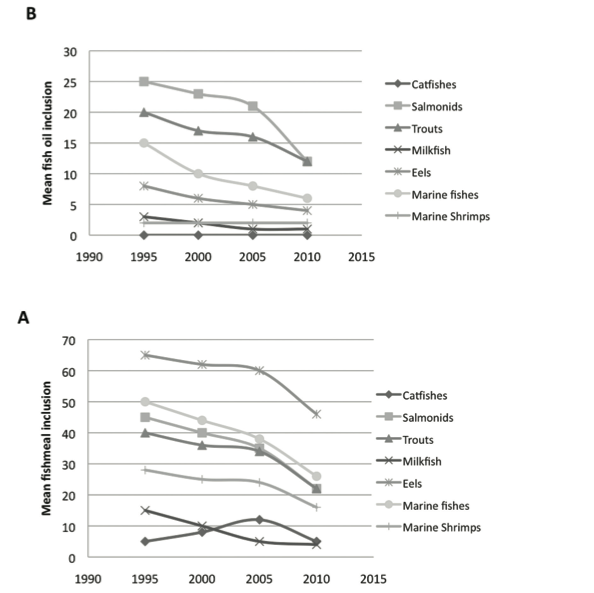
Figure 5. Estimated mean percentage dietary inclusion rate for (A) fishmeal and (B) fish oil in the different groups of farmed species between 1995 and 2010 (modified after Tacon et al. 2011) (34)
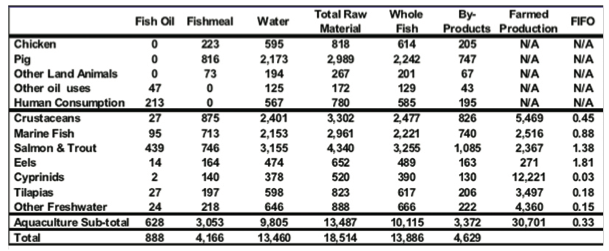
Table 2. Mass balance estimate for 2010 for combined consumption of fishmeal and fish oil inputs and fed aquaculture output (tonnes x 103) and corresponding fish-in fish-out ratios, based on whole fish inputs for different market segments (modified after Shepherd & Jackson 2012) (33).
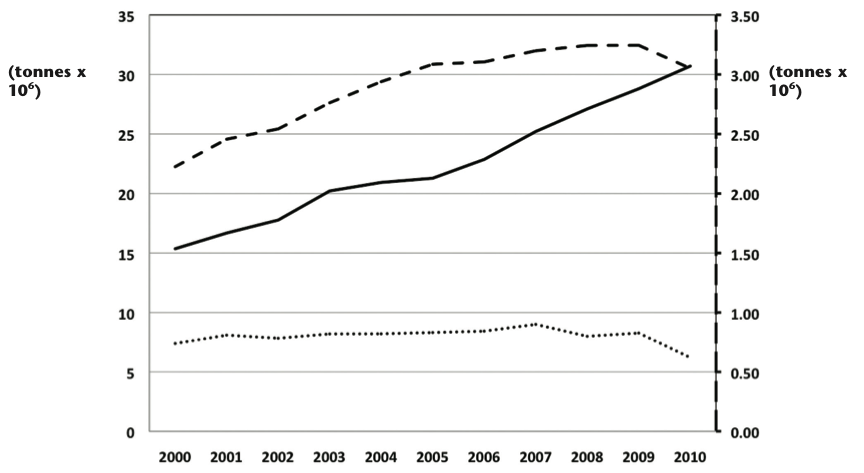
Figure 6. World fishmeal and fish oil consumption by aquaculture compared with growth in ‘fed’ aquacul- ture (millions of tonnes) during 2000-2010 (Solid line = Fed aquaculture; Broken line = Fish meal in aqua- culture; Dotted line = Fish oil in aquaculture), (left hand vertical axis refers to fed aquaculture; right hand vertical axis refers to world fishmeal and fish oil consumption by fed aquaculture). (Shepherd & Jackson 2012, based on data from IFFO and FAO 2012a) (33,2)
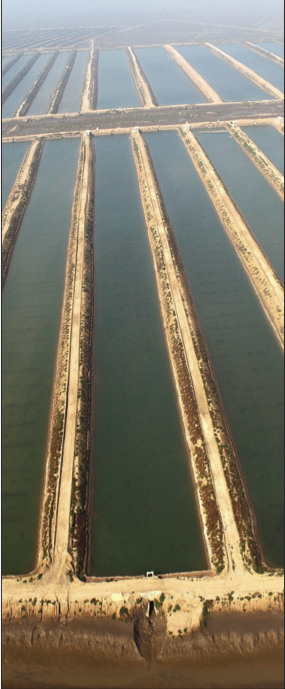
Aquaculture farm
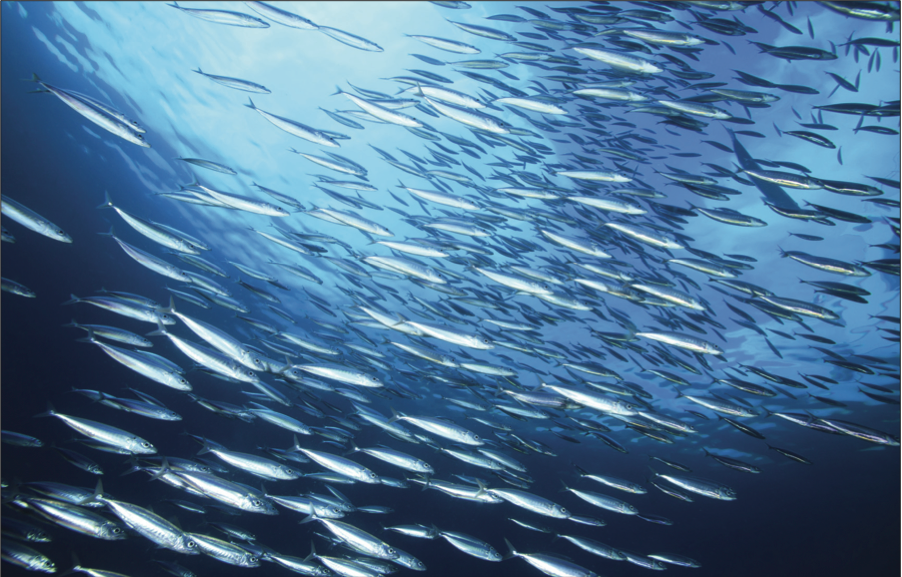
Pelagic fish: a shoal of mackerel.

